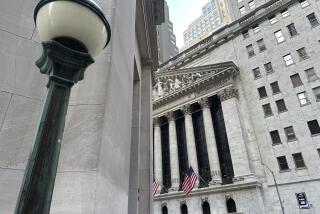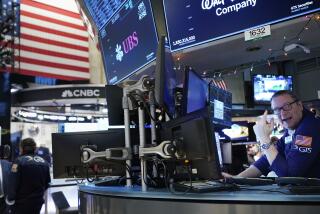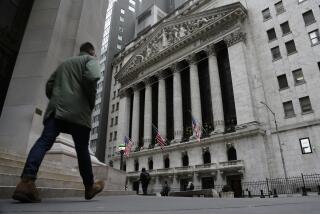Interest Rates on Treasury Issues Do a Flip-Flop : Short-Term Yields Inch Past Long Term; Condition Often Precedes Recession
- Share via
For the first time since July, 1982, interest rates on many shorter-term Treasury securities are higher than on long-term issues, the beginnings of an unusual condition known as an inverted yield curve.
For conservative, savings-oriented investors, it’s a great opportunity to get relatively high yields on safe government bonds without having to tie up money long term, advisers say. Two-year Treasury notes, for example, were yielding 9.00% on Friday, compared to 8.89% for 30-year Treasury bonds.
“This is a godsend to people who are savers,” says John D. Connolly, head of the investment policy committee at Dean Witter Reynolds. “Savers are getting a bonus.”
But for the economy, it may not be so great: Inverted yield curves often predict recessions. All eight recessions of the postwar era were preceded by inverted yield curves. And since 1953, all but one of the inverted yield curves that have lasted for at least a quarter have led to recessions, according to Dean Witter research.
“An inverted yield curve by itself does not produce a recession but is part of the process which can lead to a recession,” says Irwin L. Kellner, chief economist at Manufacturers Hanover Trust Co. in New York.
A yield curve plots the interest rates offered by Treasury securities of varying maturities. Normally, short-term Treasuries yield less than longer-term Treasuries, for the simple reason that investors demand to be rewarded for tying up their money in longer-term instruments.
Fed Needs to ‘Relax Its Grip’
But the curve has become partly inverted--meaning long-term Treasuries yield less than most shorter-term issues--because the Federal Reserve Board, in an effort to slow the economy and stem the threat of higher inflation, has pushed up short-term interest rates dramatically in recent weeks. It has done this by selling short-term securities, flooding the market, driving down the prices of these securities and raising their yields. Selling of these securities also has soaked up money in the economy, reducing growth of the money supply.
The danger of this tight-money policy, economists fear, is that the Fed may go too far and trigger a recession.
“If the Fed does not relax its grip soon, we will find ourselves in a recession by the end of 1989,” Kellner says.
Sharp rises in short-term rates can have a pervasive negative effect on the econo my. For example, homeowners with adjustable rate mortgages or home-equity loans may see their monthly mortgage payments rise sharply, since rates on those loans are often tied to short-term Treasury rates. Those higher mortgage payments could cause those consumers to cut back their spending, thus depressing retail sales which in turn could depress the economy.
Indeed, when short-term rates rose in the past sharply enough to top long-term rates, a recession followed in all but one case, Dean Witter’s Connolly says.
In 1980 and 1981, for example, yields on three-month Treasury bills actually exceeded 30-year Treasury bonds by as much as 3 percentage points, according to Dean Witter. What followed was the worst recession of the postwar era.
Only in 1966 did an inverted yield curve not result in a recession, although economic growth did sputter somewhat in 1967, Connolly notes.
But Connolly says the current version of the inverted yield curve won’t necessarily lead to a recession. First, the condition must last much longer and show a wider spread between short and long yields. Indeed, he notes, the curve currently is not fully inverted, as three-month Treasury bills still are only yielding 8.28%, less than 30-year Treasuries.
Divided Opinion
Also, he says, the Fed is well aware of the history of inverted yield curves--and does not want history to repeat itself and produce a recession.
For the Fed to let current conditions lead to a recession, “You have to presume that they are total dummies, and that (Fed Chairman Alan) Greenspan has forgotten 40 years of economic experience in the last 18 months,” Connolly says.
The economy’s fate aside, experts are divided as to whether investors should buy shorter-term Treasury securities under current conditions.
Irene D. O’Neill, portfolio manager for the Evergreen American Retirement Trust, a mutual fund, says conservative savers should stay short term so they can get better yields. Also, prices of long-term Treasuries will fall if interest rates continue to rise, she notes.
“If you buy now and interest rates go up, the long-term bond is worth less,” O’Neill says. “It’s difficult to time when interest rates will peak.”
But others, including many institutional investors, disagree and are buying long-term bonds. That is keeping long-term yields down, preserving the inverted yield curve. (If more people were buying short-term securities, that would drive their yields down and thus stop the yield curve from being inverted.)
Why are investors so willing to go long term? Because they are anticipating that interest rates will soon peak, Dean Witter’s Connolly says. And once rates start to fall, long-term bonds will gain in value, he says.
“If rates go down, you can’t get much price appreciation out of a two-year note, and you certainly can’t get any out of a (short-term) Treasury bill,” Connolly says. Also, he adds, once a short-term bond matures, you have to reinvest that money. But if interest rates have fallen in the meantime, you will have to accept a new, lower yield.
“So why buy a two-year note? Why not buy a 10 year?” he asks.
More to Read
Inside the business of entertainment
The Wide Shot brings you news, analysis and insights on everything from streaming wars to production — and what it all means for the future.
You may occasionally receive promotional content from the Los Angeles Times.










